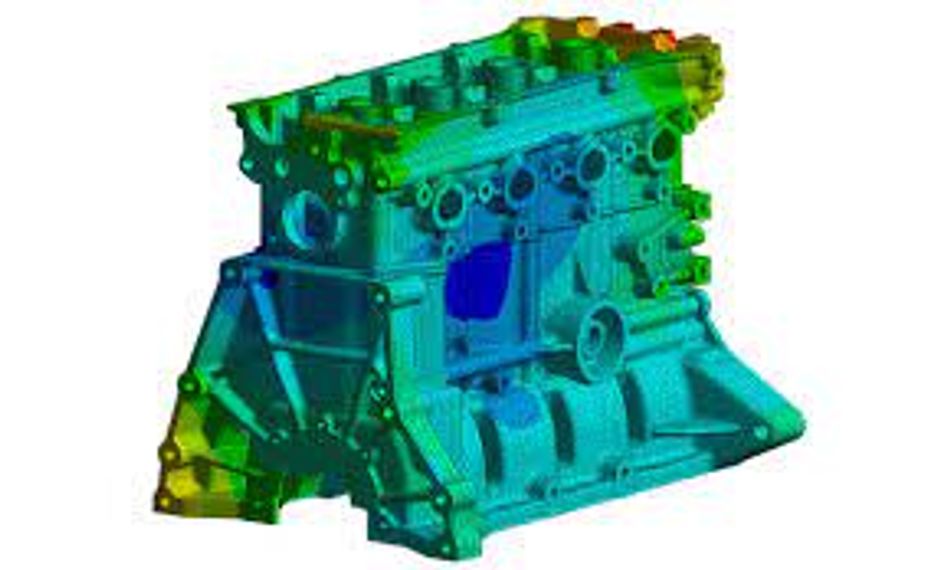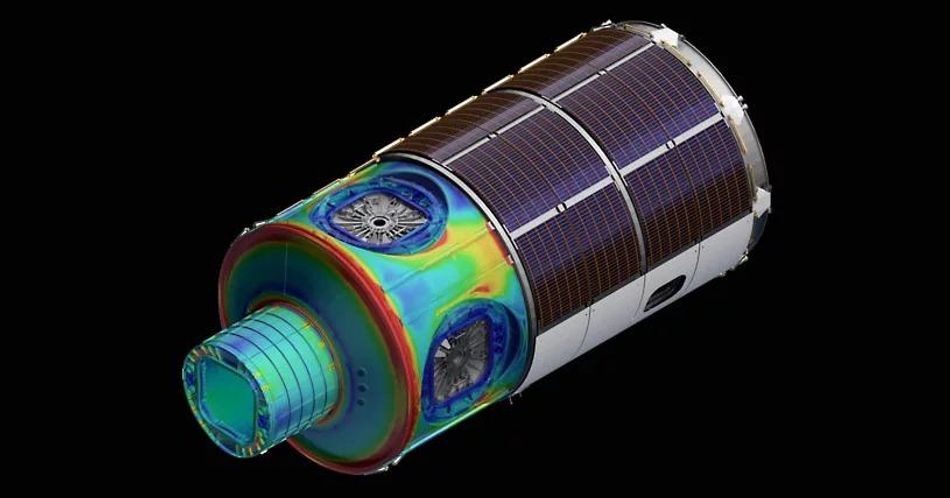Shocks, Drops, Smashes, and Crashes: How to Overcome Tough Structural Challenges
Article #2 Simulation Education Series. Exploring how engineers might design a commercial space station accurately and cost-effectively using mechanical analysis techniques
This is the second article of a 3-part series looking at engineering fundamentals and exploring how they are applied in innovative engineering case studies. We further demonstrate how free online courses can elevate your knowledge – no matter your engineering experience. The Axiom Space case study described in this article is based on the article on this story available on Ansys.com.
Structural analysis is a crucial component of engineering design and product development. It is used to determine whether parts, systems, and machines are safe, reliable, and fit for use. In this article, we will define structural analysis and look at the different methods available to engineers, including calculations, physical testing, and simulation. For complex designs, different simulation tools may need to be used in conjunction with one another to accurately reflect the true loading seen on the parts. To illustrate an example of complex loading and structural analysis simulation tools we explore the case study of designing a commercial space station.
What is structural analysis?
Structural analysis is the use of calculations and predictive methods within mechanical engineering to determine the stress, strain, forces, deformation, and potential failures that a part will experience under loading conditions. When a part or a structure is in service it will undergo loading (or external forces) from:
- Environmental conditions (the sun, wind, weight of structures attached to it or resting on it, etc.),
- Operational loading (forces exerted on the part, heat cycles when the part or system is in use, repetitive weight and impact on structures like a car’s suspension, a bridge, or a building), and
- Edge case conditions (such as crashes and smashes, impact from being dropped, or extreme forces in storm conditions).
These loading conditions will act on the part and create stress within it, which is force per unit area. Due to the stress, the part will also experience strain, which is a measure of its deformation. Engineers can use the predicted stress and strain results from their analyses to determine if the part has the material strength to be structurally sound, meaning it will not fail while in service. Another term for ensuring the safety, strength, and whether an engineering design is fit for purpose is structural integrity.
The evolution of structural analysis methods to solve mechanical engineering problems
Structural analysis has always been a part of engineering, but as computational powers increased along with the creation of the finite element method just over 80 years ago, digital simulation methods have become standard within engineering. These simulation tools allow engineers to apply their analyses to complex structures, systems, and machines, where traditional hand calculations would be impossible. Engineers will also use mechanical analysis techniques through physical testing, by applying the loads onto a test part and using strain gauges to measure the deformation. They can then compare the physical test results to their digital simulation results in order to increase their confidence in the design.
Structural analysis simulation tools predict the stress and strain of a component or system when given the loading conditions and constraints. Advanced simulation tools that engineers use today can predict stress, strain, and failure under extreme conditions, including:
- Shock
- Drop
- Vibration
- Impact
- Penetration
- Smashes and crashes
- Heat transfer
- Solder fatigue
- Repetitive loading
When design teams are tasked with creating a new product, machine, or system, one of the first sets of data they require is the load cases and/or operating conditions. For example, if the engineering team is designing a new electric vehicle, they would need to acquire not only the expected suspension loads, for structural analysis on those components, but they would also need the crash test specifications for the country they expect to sell the vehicle in.
The suspension components could be designed, analyzed, and then optimized much earlier on in the design cycle because the engineers would have a good idea of the expected loads and the targeted vehicle weight. They would use simulation to make the suspension components as light as possible without compromising their required strength, stiffness, and fatigue life.
Once the main structural design of the vehicle has reached a point where engineers have packaged all required components and the body panels, drivetrain, suspension, batteries, and internal structures, like crash rails, roll cages, and bumpers, have been fleshed out in CAD, then crash analysis can begin. For all regions of the world, there are established test procedures that must be passed in order for a vehicle to be deemed safe for the market.
These procedures can be translated into simulation trials where engineers can predict the crashworthiness of the vehicle and adjust any structural elements if the simulations suggest that the vehicle would see too high of a load through the dummy in the vehicle or if the damage to the vehicle is too great. In a case like this, both crash testing and occupant safety simulations are combined to determine if the structural integrity is sufficient.
In any product development scenario, from small single parts to large systems, as the design progresses, the analyses will be re-run with more up-to-date geometry and material properties. By leveraging as much simulation as possible, engineers can get the design very close to completion prior to any necessary physical tests. In the example of crash testing, a mule car will be built and tested in a dedicated facility using test sleds that impact the vehicle at specific speeds and angles.
Without simulation, engineers had to rely on hand calculations, previous experience, and much more costly physical testing. Simulation has made it possible to efficiently further the design of complicated systems, through iterative analyses and the combination of simulation types.
How structural analysis is helping deliver the first commercial space station
In 2020, space engineering startup, Axiom Space, won the NASA contract to build the first commercial space station. Their station will be initially attached to the forward node of the International Space Station (ISS). The company was formed in 2016 by Michael Suffredini and Dr. Kam Ghaffaian. Suffredini was the ISS Program Manager for NASA for 10 years, and Dr. Ghaffarian founded the second-largest contractor of engineering services to NASA. Their design called the Axiom Hub One, will host exciting future experiments to investigate manufacturing products in microgravity.
In order to get to the point where these important experiments can be conducted in Axiom Hub One in space the extensive mechanical analysis of the station must be first conducted on Earth. Because the conditions are unable to be replicated on earth, complex simulations of the station are underway.
Designing for Extreme temperatures and pressure
The load conditions experienced by a space station are extreme and vary wildly from the conditions experienced by a vehicle for use on Earth. For example, the space station’s panels will experience temperatures several hundred degrees greater on the side of the space station nearest the sun compared to the side facing away from the sun. The heat transfer implications of these extreme conditions could result in buckling or separation if not designed correctly.
In addition to the heat transfer considerations, there will be a massive pressure differential between the inside and the outside of the Axiom Hub One when it is operational in space. The inside will need to be pressurized for the astronauts, while the outside will be under vacuum conditions.
The launch of Axiom One into space adds another set of loading conditions to analyze in order to ensure the structure will not be damaged during its departure.
The design of the station will need to be tested under each (and many more) specific conditions. Engineers will use a combination of simulation tools to capture both external and consequential loads on the station. For example, engineers at Axiom One would need to use both heat transfer simulations to determine the expansion and contraction of the structure, and mechanical analysis to ensure that the deformations would not cause any critical stress risers, cracks, or failures in the material.
Axiom Space joined the Ansys Startup Program to facilitate their structural analysis simulations
Axiom Space joined the Ansys Startup Program which gave them access to Ansys Mechanical and Ansys Fluent software as well as the support and guidance of Ansys experts. By rigorously testing, improving and refining the design of the station using rigorous computational analysis is a cost-effective way for Axiom Space to further the design and learn more about the structural loading seen on the space station.
Ansys Free Innovation Courses
Going deeper into mechanical engineering design and analysis
Learning how to conduct mechanical analysis using Ansys simulation software is not just reserved for aerospace engineers and dedicated simulation analysts. The free Getting Started with Ansys Mechanical Course, provides a free and fast way to become familiar with the Ansys Mechanical interface. The course also provides important tips and tricks to increase your productivity within the simulation workflow. You’ll also learn how to integrate structural analysis simulation with other packages available through Ansys in order to optimize product development conditions. In the first part of the course you will be become familiar with
Ansys Workbench - the platform that allows engineers to connect simulations through a workflow. It also enables the analyses to be organized into a logical schematic format.
The learning within the course isn’t limited to the theoretical. The geometry files and the archived Ansys Workbench files used in the lessons can be downloaded enabling you to gain hands-on skills for organizing your workflows and conduct related simulations.
To get even more hands on, the introductory simulation software package, Ansys Student, is available to download, giving you free access to Ansys Mechanical, Ansys Fluent, and more.
Once you are familiar with the interface and you have the free student version of the software at your disposal, you can undergo the free Stress Analysis in Solid Mechanics Course online. Like Axiom One engineers using Ansys Mechanical to better understand their designs, this course, will give you a foundation in how to use structural analysis to understand stress and strain under a particular set of loading conditions.
The course begins by explaining the importance of analyzing mechanics using real-world examples of products and structures. You’ll also learn how analysis of solid mechanics is conducted, and then you’ll get into the details of running your own simulations in Ansys Student. You’ll be able to look at stress distributions in particular components and look at how mechanical parts are optimized during product development. Both courses together, which are free to take online, provide an introduction to mechanical analysis and how to use Ansys simulation tools to dive deeper into how to set up trials, review results, and use engineering judgment in product design.
This is the second article in a three-part series.
Article one examined heat transfer simulation.
Article two provided an overview of mechanical analysis.
Article three looked at contact mechanics.
About the sponsor: Ansys
Ansys provides engineering simulation software used to predict how product designs will behave in real-world environments. Founded in 1970, Ansys employs more than 4,400 professionals, many of whom are expert M.S. and Ph.D.-level engineers in finite element analysis, computational fluid dynamics, electronics, semiconductors, embedded software, and design optimization.




